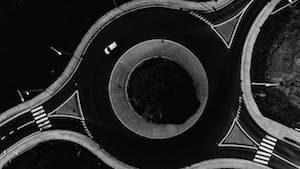The bill title sounds like it could make a good movie or book title for some reason. But I digress. The
Senate is considering Rep. Torr’s HB 1039 on second reading. It’s part of the Carmelization of our roadways and governs the right of way in roundabouts. (I see that the legislation does away with the term “rotary traffic island.”)
I had a little trouble visualizing what was going on from the language. But, it sounds like if you’re dealing with two or more lanes in the roundabout, cars have to yield to long or wide trucks (40 feet long and/or 10 feet wide) and if there are two long trucks in the roundabout, the one on the right has to slow down and yield to the one on the left.
Like I said, I might have this wrong, but it sounds like a situation where the long truck might not be keeping to its lane very well. The duty to yield doesn’t apply when the truck is entering the roundabout from the side. If it’s only one lane wide, then I don’t see where yielding within the roundabout would come up. And, if it’s separate lanes, ordinarily there wouldn’t be any yielding because you each have your own lane. But, if you have a long truck and a tight circle, staying in your lane might be a little tough.
Still, if there is a collision, I wonder how the negligence issue shakes out — the truck is going to say that the car had a duty to yield while the car is going to say that the truck had a duty to stay in its lane.

Given differences in driver education and experience in North America I have questions about roundabout safety for pedestrian traffic. http://nacto.org/docs/usdg/effects_roundabouts_pedestrian_safety_stone.pdf
The law makes sense to me. It is to protect box trucks and semi-tractors with trailers from being at fault when they can’t stay in their lane while in the roundabout. One thing I would like for them to add is a clear language that says once a vehicle enters a lane within a roundabout that vehicle must stay within that lane. While many double lane roundabouts have solid white lane markings, there are too many areas (mostly the entry/exit spokes) where the lines aren’t painted or become hashed. This could cause confusion and a clear law that basically says stay in your lane would help with finding fault for collisions. There are too many people who will enter one lane where posted signs force them to exit the next spoke 1/4th the way or 1/2 the way around, but they change lanes to go to the spoke 3/4ths the way around to exit. Also, some of these people will just lie to an officer claiming they had a right to exit at the 3/4ths way around by claiming they entered the spoke on the opposite end instead of where they truly entered from.